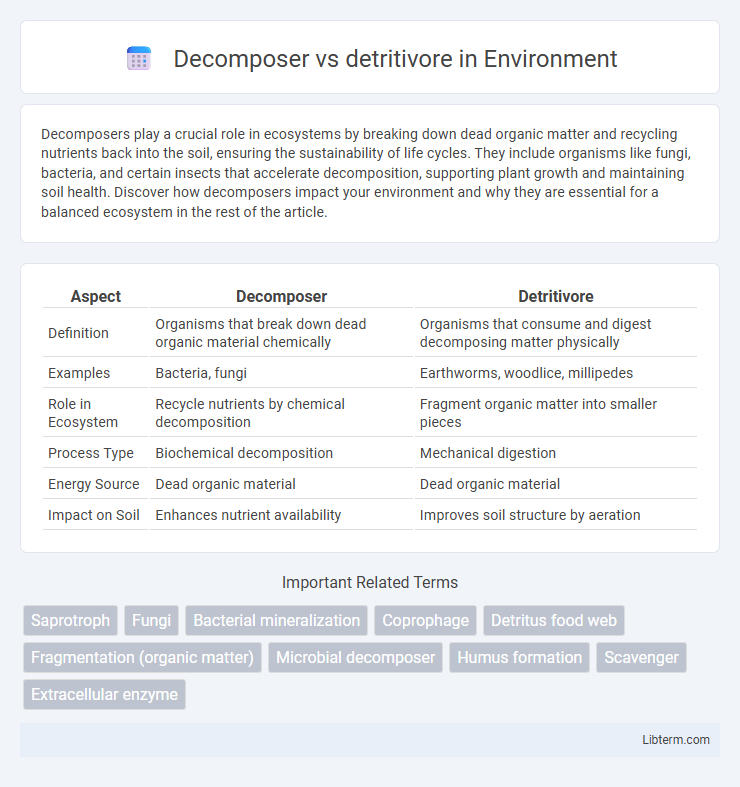Decomposers play a crucial role in ecosystems by breaking down dead organic matter and recycling nutrients back into the soil, ensuring the sustainability of life cycles. They include organisms like fungi, bacteria, and certain insects that accelerate decomposition, supporting plant growth and maintaining soil health. Discover how decomposers impact your environment and why they are essential for a balanced ecosystem in the rest of the article.
Table of Comparison
| Aspect | Decomposer | Detritivore |
|---|---|---|
| Definition | Organisms that break down dead organic material chemically | Organisms that consume and digest decomposing matter physically |
| Examples | Bacteria, fungi | Earthworms, woodlice, millipedes |
| Role in Ecosystem | Recycle nutrients by chemical decomposition | Fragment organic matter into smaller pieces |
| Process Type | Biochemical decomposition | Mechanical digestion |
| Energy Source | Dead organic material | Dead organic material |
| Impact on Soil | Enhances nutrient availability | Improves soil structure by aeration |
Introduction to Decomposers and Detritivores
Decomposers, primarily bacteria and fungi, break down dead organic matter at the molecular level, recycling nutrients back into the ecosystem. Detritivores, such as earthworms, millipedes, and woodlice, physically consume and fragment dead material, facilitating decomposition. Both play essential roles in nutrient cycling and maintaining soil health within ecosystems.
Definitions: What Are Decomposers?
Decomposers are microorganisms such as bacteria and fungi that chemically break down dead organic matter into simpler substances, recycling nutrients back into the ecosystem. They play a crucial role in nutrient cycling by decomposing complex molecules at a microscopic level. Unlike detritivores, decomposers absorb nutrients directly through enzymatic processes rather than ingesting solid organic material.
Definitions: What Are Detritivores?
Detritivores are organisms that feed on dead organic matter, breaking it down into smaller particles through ingestion, which aids in nutrient recycling within an ecosystem. Unlike decomposers, which chemically break down organic material via enzymatic activity outside their bodies, detritivores physically digest the material internally. Common detritivores include earthworms, woodlice, and certain insect larvae, all playing a crucial role in the decomposition process by fragmenting organic matter and facilitating microbial action.
Key Differences Between Decomposers and Detritivores
Decomposers, such as bacteria and fungi, chemically break down dead organic matter into simpler substances through enzymatic processes, facilitating nutrient recycling in ecosystems. Detritivores, including earthworms and woodlice, physically consume and fragment dead material, enhancing decomposition by increasing surface area for microbial action. The key difference lies in decomposers performing external chemical breakdown, whereas detritivores ingest and digest organic debris internally.
Similarities and Overlapping Roles
Decomposers and detritivores both play crucial roles in nutrient cycling by breaking down organic matter from dead plants and animals into simpler substances. Decomposers, primarily fungi and bacteria, chemically digest organic material at a microscopic level, while detritivores such as earthworms and millipedes physically fragment and consume detritus, facilitating microbial decomposition. Their overlapping roles accelerate the decomposition process, maintaining soil fertility and ecosystem health through efficient recycling of carbon, nitrogen, and other vital nutrients.
Examples of Common Decomposers
Common decomposers include fungi, such as mushrooms and molds, which break down organic matter by secreting enzymes, and bacteria, which decompose dead plants and animals at a microscopic level. Earthworms and certain types of insects like beetles and ants serve as detritivores by consuming decaying material and contributing to nutrient recycling. Unlike detritivores, decomposers chemically break down organic substances into simpler compounds, essential for soil fertility and ecosystem health.
Examples of Common Detritivores
Earthworms, woodlice, and dung beetles are prominent examples of common detritivores, organisms that consume dead organic matter and facilitate nutrient recycling in ecosystems. Unlike decomposers such as fungi and bacteria, detritivores physically break down litter by ingesting and fragmenting it, accelerating decomposition processes. These detritivores play a crucial role in soil health and carbon cycling by enhancing organic material breakdown and nutrient availability for plants.
Ecological Importance in Nutrient Cycling
Decomposers, including fungi and bacteria, break down organic matter at a molecular level, recycling essential nutrients such as nitrogen and phosphorus back into the soil, which supports plant growth and ecosystem productivity. Detritivores, like earthworms and woodlice, physically fragment dead organic material, enhancing microbial decomposition and improving soil aeration and structure. Together, these organisms play a critical role in nutrient cycling by converting organic waste into bioavailable forms, maintaining soil fertility, and sustaining terrestrial and aquatic food webs.
Impacts on Soil Health and Ecosystems
Decomposers such as fungi and bacteria chemically break down organic matter, releasing essential nutrients like nitrogen and phosphorus directly into the soil, which enhances soil fertility and promotes plant growth. Detritivores, including earthworms and millipedes, physically fragment organic material, increasing surface area for microbial decomposition and improving soil structure through aeration and aggregation. Together, these organisms drive nutrient cycling and maintain ecosystem stability by facilitating organic matter turnover and supporting biodiversity in soil habitats.
Conclusion: Decomposer vs Detritivore in Nature
Decomposers, such as fungi and bacteria, break down organic matter at the chemical level, recycling nutrients directly into the ecosystem. Detritivores, including earthworms and woodlice, physically consume and fragment dead material, facilitating decomposition by increasing surface area for decomposers. Both play essential, complementary roles in nutrient cycling and maintaining soil health in natural environments.
Decomposer Infographic

 libterm.com
libterm.com